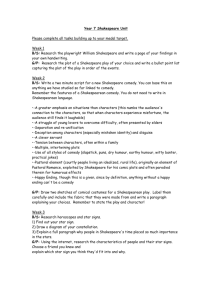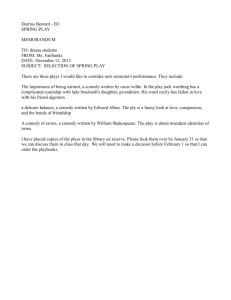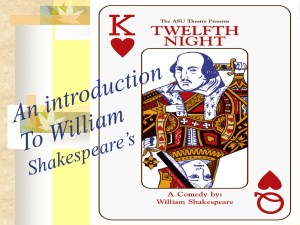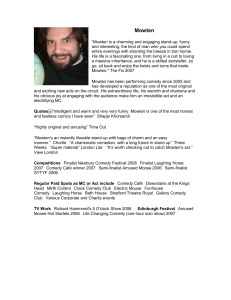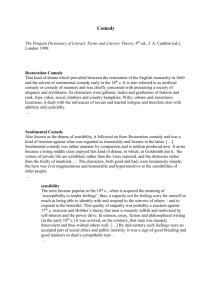Shakespeare and comedy Lesson plan
advertisement
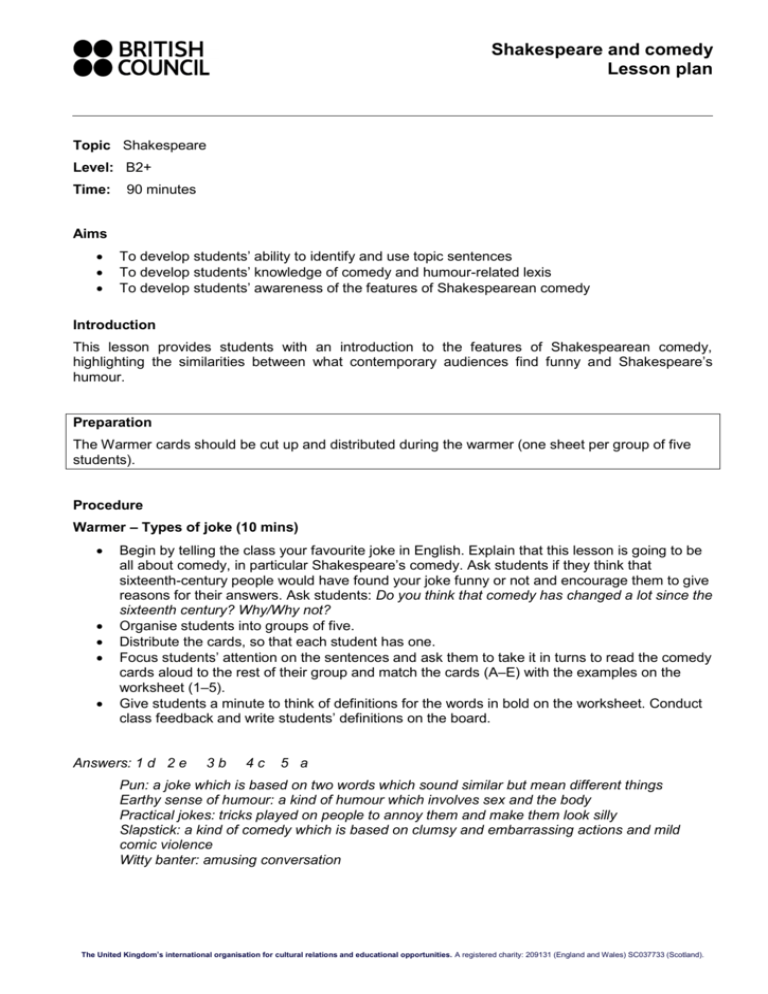
Shakespeare and comedy Lesson plan Topic Shakespeare Level: B2+ Time: 90 minutes Aims To develop students’ ability to identify and use topic sentences To develop students’ knowledge of comedy and humour-related lexis To develop students’ awareness of the features of Shakespearean comedy Introduction This lesson provides students with an introduction to the features of Shakespearean comedy, highlighting the similarities between what contemporary audiences find funny and Shakespeare’s humour. Preparation The Warmer cards should be cut up and distributed during the warmer (one sheet per group of five students). Procedure Warmer – Types of joke (10 mins) Begin by telling the class your favourite joke in English. Explain that this lesson is going to be all about comedy, in particular Shakespeare’s comedy. Ask students if they think that sixteenth-century people would have found your joke funny or not and encourage them to give reasons for their answers. Ask students: Do you think that comedy has changed a lot since the sixteenth century? Why/Why not? Organise students into groups of five. Distribute the cards, so that each student has one. Focus students’ attention on the sentences and ask them to take it in turns to read the comedy cards aloud to the rest of their group and match the cards (A–E) with the examples on the worksheet (1–5). Give students a minute to think of definitions for the words in bold on the worksheet. Conduct class feedback and write students’ definitions on the board. Answers: 1 d 2 e 3b 4c 5 a Pun: a joke which is based on two words which sound similar but mean different things Earthy sense of humour: a kind of humour which involves sex and the body Practical jokes: tricks played on people to annoy them and make them look silly Slapstick: a kind of comedy which is based on clumsy and embarrassing actions and mild comic violence Witty banter: amusing conversation The United Kingdom’s international organisation for cultural relations and educational opportunities. A registered charity: 209131 (England and Wales) SC037733 (Scotland). Shakespeare and comedy Lesson plan Note To wind someone up: to tease someone To take the mickey out of someone: to make fun of someone Task 1 – Reading: making predictions (5 mins) Tell students that they are going to read a blog post about Shakespeare’s comedies. Focus students’ attention on the list. Give them a few moments to tick the items they think they will read about. Ask a couple of students to tell you about their predictions. Task 2 – Reading a blog post (5 mins) Focus students’ attention on the blog post. Ask them to read it quickly and see whether their predictions were correct. Conduct class feedback. Answers: All of the items on the list feature in the blog post. An earthy sense of humour is not mentioned in these exact words, but sexual innuendo is a feature of this type of humour. Task 3 – Reading: topic sentences (5 mins) Read the topic sentences aloud to your students. Ask students to read the text again more slowly and insert the sentences in the correct places. Allow students to compare their answers with a partner before conducting class feedback. Elicit the effect which the topic sentences have on the text (they help the reader follow the text more easily, as they make it clear what the paragraph is going to be about). Answers: 1 e 2a 3d 4c 5b Task 4 – Writing: topic sentences (10 mins) Note – as Task 4 deals with topic sentences, rather than the blog post, you may prefer to go straight to Task 5 at this point, and to return to Task 4 later, or set it as homework. Organise students into pairs. Ask them to read the paragraphs together, decide what they are about and write an appropriate topic sentence for each. Nominate a few students to read their topic sentences aloud to the rest of the class. Write the best topic sentences on the board. Suggested answers: A. I’ve loved Shakespeare ever since I was a child B. Shakespeare’s work can be unpopular with young people 2 The United Kingdom’s international organisation for cultural relations and educational opportunities. A registered charity: 209131 (England and Wales) SC037733 (Scotland). Shakespeare and comedy Lesson plan Task 5 – Reading: checking your understanding (10 mins) Ask students to read the text again and answer the questions. Organise students into small groups to discuss their answers. Monitor as students do this, offering support where necessary. Briefly check answers around the class. Answers: 1 He thinks his mum should relax because most contemporary comedies are inspired by Shakespeare, and so are not too far away from his studies. 2 They both make a mess of their duties, but also do good in the end. They speak words of truth to the audience. 3 Absurd humour, puns (Bottom and ass) and earthy humour (Bottom and ass) 4 With marriage Task 6 – Vocabulary (10 mins) Focus students’ attention on the sentences and ask them to match these with the words in bold in the text Allow students to check their answers with a partner before conducting class feedback. Answers: a. romcom b. serenades c. obstacles g. sexual innuendo h. chuckling i. prototype d. inadequate e. screws up f. witty banter Task 7 – Vocabulary practice (10 mins) Ask students to complete the sentences using words from Task 6. Stress that students need to use the correct forms of the word. Monitor as students complete this task, offering support where necessary. Check answers around the class. Answers: a. chuckling b. serenading c. sexual innuendo f. obstacles g. romcom h. witty banter i. prototype d. screwed up e. inadequate Task 8 – Creating a Shakespearean comedy (25 mins) As a class, brainstorm the ingredients of a Shakespearean comedy, e.g.: o puns o earthy humour o fools o ending in marriage o singing and dancing o etc. Organise students into groups. Tell them that they have five minutes to think of their own idea for a romantic comedy film which features these ingredients. Ask students to use the questions on their worksheets to help them. Ask students to choose one scene from their film to act out to the rest of the class. Give them five minutes to prepare and practise their scene. The groups should then take it in turns to act out their plays. After each performance, discuss which features of Shakespearean comedy the scene contained. 3 The United Kingdom’s international organisation for cultural relations and educational opportunities. A registered charity: 209131 (England and Wales) SC037733 (Scotland).
